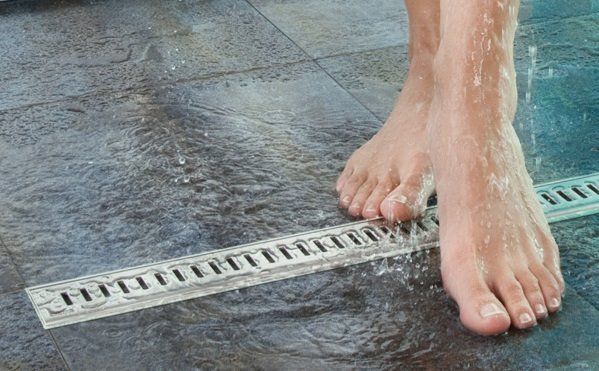Floor Drains Seattle, Washington

A floor drain is basically a plumbing fixture that is placed in the ground floor of a building, mostly to eliminate any stagnant water close to it. They are typically round, although can also be rectangular or square. They can range in size from 2 inches to 12 inches; many are actually larger. They are placed by curbs, along the walls and even in basements.
You might ask why someone would put something like this in an area where there is free standing water. The answer is simple. Water that accumulates over time can create a hazard. It may be the result of a leaking pipe or septic tank, for example. A floor drain acts as a virtual filter that catches and removes any excess water.
Drainage Systems
Floor drains are typically connected to a kitchen, bathroom or other outhouse where large volumes of water can accumulate. There are several different kinds to choose from. In some instances you will need to purchase a "cleanout plug" to plug the trap. However, not all models require a cleanout plug.
Some floor drains are made with a long, flexible hose attached. This fixture is called a "snake trap." Usually made of stainless steel or polypropylene, this fixture can fit through very small holes. To ensure the seal around the trap remains intact, some manufacturers place a layer of rubber primer on the inside of the trap. This prevents the seal from deteriorating over time.
Another type of floor drain is one that is used with hot water heaters. These are often called "with-frame" fixtures. As the term suggests, they are placed next to a hot water heater. If you have an old water heater, you may need to install a trap that extends down the inside of the pipe. New construction usually has holes that provide plenty of room for this kind of fixture. If you have a new construction and are replacing an older one, be sure to check to make certain the old one is compatible with the new installation.

Lead Gen Contact Form

Drainage Traps
A trap is sometimes used to help remove sediment from ground water. Sometimes, when there is sediment in a sump pit, there is also a buildup of excess sediment in a drain line. To remove the sediment, you should use a "sump pump trap" or a sump pan.
Many basement waterproofing systems require backwater valves. (They are also referred to as "backwash traps," "bathtub traps," or "washer traps," depending on the specific manufacturer.) In order to use backwater valves, you must have a backwater valve on each main water supply pipe and a second trap - the trap that connects to the sump pump - installed at least three feet away from the first. If your drainage system does not have a backwater valve or a second trap, it is recommended that you install one as soon as possible, and that trap should be within easy reach.
If your foundation has a clay layer below the surface, you may need to excavate around the foundation to install the proper floor drain tile. (Note that this option is not recommended for areas where heavy rain or snowfall is common, since the risk of damage is great. Also, if you do choose to dig around your foundation to install your floor drains, you should only do so after the area has been cleared of all debris. Otherwise, you may face the risk of flood damage to your basement as a result of excess water sitting against your house's interior walls, a concern that could necessitate consulting Seattle Drain Pros.
Sump Pumps
Sump pumps can be powered either by electricity or by sewage gas. If your water-supply pipe is located directly under the house, then your best bet is to go with a sump pump that operates by electricity, since this provides the most reliable water flow. Sewer gas powered floor drains are relatively less expensive and safer than electricity powered models, but their range of operation varies depending on the model. For best results, you should always opt for a sump pump that will run off a household waste water pump, since these devices will always run properly even if there is a problem with your waste water plumbing system.
Installing basement floor drains is not a major project, but it is something that you should not overlook. The basement floor drains will serve as a way to minimize the amount of water that seeps into your basement. You should also take special care to prevent sewer gas from leaking into your home. By using proper basement floor drain installation techniques, you can help minimize the risks of a leaking sewer system and avoid excess amounts of water damage.
Floor drains come in many different types. The easiest to install are the perforated types that you can purchase in hardware stores. These fixtures fit on the top surface of the ground water pipes, providing an exit point for the homeowner's sewer line. Other types of floor drains are the trap-style fixture that come with a bottom feeder, and the submersible kind that have its trap fitted at the bottom of the pipe. There are many other types of fixtures that you can buy, so it is important that you consider your options carefully before making a decision. The location of where you are planning to install the floor drain will help you decide on the best fixture for your basement.
Discover how to protect your home from water damage—explore our blog for expert articles.
Frequently Asked Questions
What is a floor drain, and how does it work?
A floor drain is installed in basements or garages to direct water into the drainage system, helping to prevent a flooded basement.
Do I need a sump pump with my floor drain?
While floor drains can handle minor water, a sump pump installation ensures effective water removal during heavy rainfall or flooding.
How do I maintain my floor drains?
Regular cleaning is essential to prevent clogs and ensure that your drain continues to function properly.
Are floor drains part of basement waterproofing?
Yes, floor drains are often included in comprehensive waterproofing systems, along with sump pumps and French trench drains.
Can floor drains prevent foundation damage?
Yes, by directing water away from your foundation, floor drains can help prevent water buildup and foundation cracks.